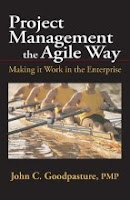Students of agile project management with real experience and success with traditional project practices and methodology come to class more often than not with these three questions at the top of their list of things to learn:
1. What is this thing called agile?
2. How do I work agile into my traditional environment?
3. How do I get started?
 Fortunately for them, I wrote the book!
(But, so have others. Just take a look at my library for the ones I like)
Fortunately for them, I wrote the book!
(But, so have others. Just take a look at my library for the ones I like)But, back to the Big Three FAQ. Here's my 'elevator speech' for those without the time to read the book:
To Point 1:
Agile begins with the Agile Manifesto and the Agile Principles, which in the main redirect the project focus to the 'ends' as having a higher priority than the 'means'.
The management focus is first on outcomes and results and only second on inputs, like cost and schedule.
Agile is a change-driven quality-centric methodology that seeks to deliver "best value": the most important, urgent, needed scope possible for the investment offered by the project sponsor, where maximum fidelity to customer need is the driving factor.
Now to the second point, agile in the traditional environment:
First, make agile its own swimlane or WBS vertical. Such allows the agile method to run along somewhat unencumbered and unencumbering to the other swim lanes with traditional methods
Second, work out strick interface definitions/specifications/functionalities between the agile deliverables and the traditional deliverables. In other words, control the integration between swim lanes at the interfaces
And, third, keep to the overall narrative developed first in the business case and flushed out a bit in the project charter. Inevitably, agile in less-than-a-green-field is going to be more constrained than otherwise.
And to Point 3, how to get started?
You get started with a pilot project. Mike Cohn has some excellent advice on this: pick something important, but constrained. Get the buy-in of a sponsor for the pilot, do some training, line up a coach or mentor, and then give it a go.
Check out these books I've written in the library at Square Peg Consulting

